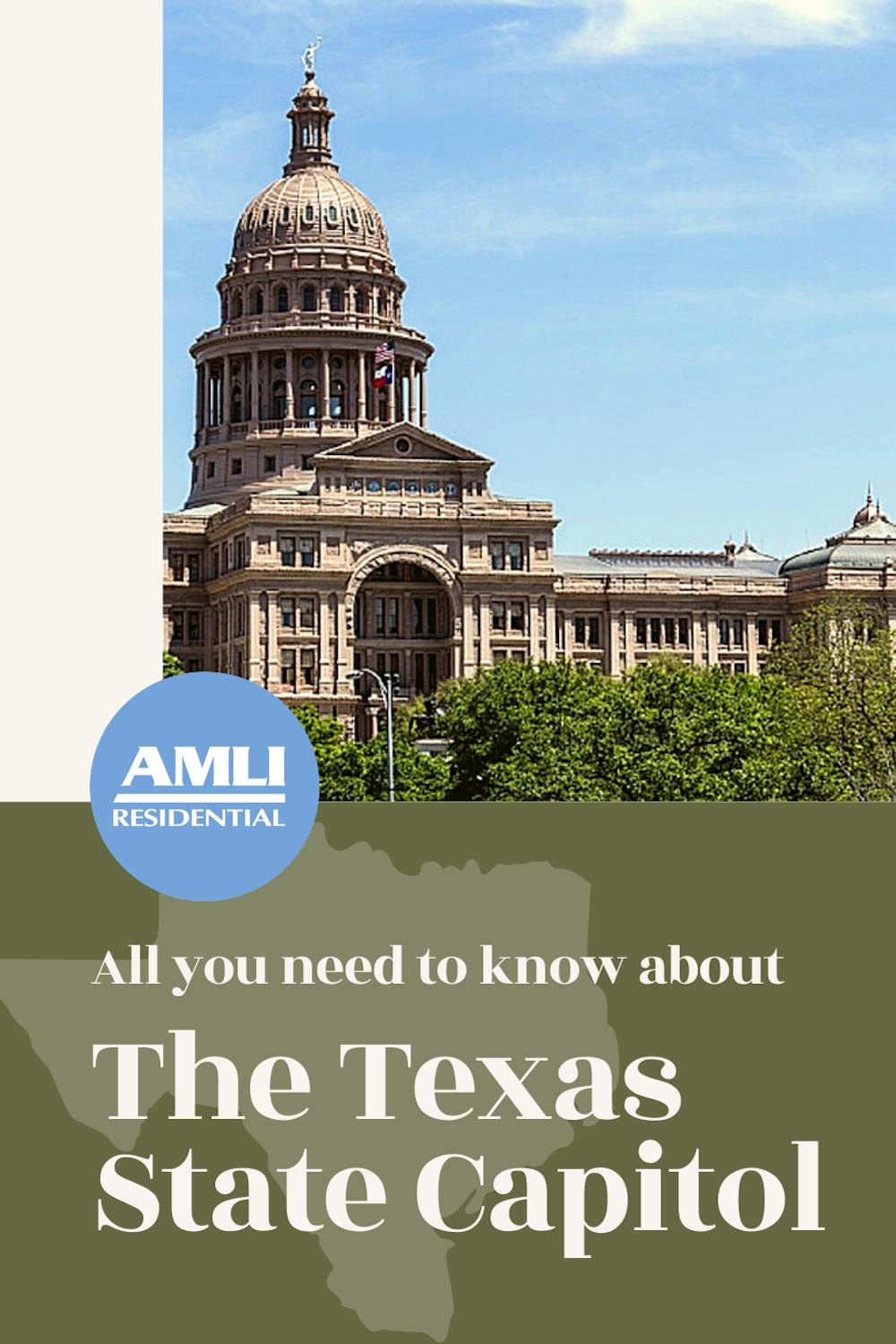If you’ve ever seen the Texas State Capitol Building in Austin, Texas, then you already know that it is quite a sight to behold. Located in the heart of Downtown Austin, the Texas Capitol is no stranger to wondrous gazes and awestruck stares, as it’s Old World architecture and reddish granite stand in stark contrast to the skyscrapers surrounding it.
If you live in our Old West Austin apartments, then you’re just blocks away from this amazing piece of Austin history and culture. It’s hard to miss this grand building, especially since it’s right in the middle of the Medical District, Downtown and the UT-Austin area. The grand dome, mimicking that of the nation’s capitol building in Washington D.C., can be seen from Congress Avenue as far south as Lively Middle School in Travis Heights! Needless to say, the Texas Capitol is a huge part of Austin’s downtown.
So, if you’re looking to spend a little time around the Texas State Capitol in Downtown Austin, then here are a few things to know about the iconic building so that you can truly appreciate its significance.
A little bit about the Texas State Capitol
The first Texas State Capitol was a small log cabin with a grand total of two big rooms and a handful of smaller meeting rooms. It actually served as the capitol building for the Republic of Texas, back when it was a sovereign state in the years 1836 to 1846.
The second capitol was built after the United States annexed Texas in 1845. This next capitol was built in 1853 at the same place where the current capitol stands. This second capitol was a large, block-shape limestone building with a small dome sticking out the top. It was destroyed, however, just 18 years later in 1881 by a fire.
Before the fire, however, plans had already gone underway to build a new and improved state capitol. An architect from Detroit named Elijah E. Myers had won the design competition and was given a whopping total of $1,700 as prize money as a reward for his design. Construction began when the cornerstone was laid on March 2, 1885.
The massive construction project was paid for by exchanging nearly 3 million acres of land to the builders. This land, located in the Texas Panhandle, became the XIT Ranch, the largest cattle ranch in the world, running for 200 miles along the border of New Mexico with a width of around 20-30 miles.
The Texas Capitol, if you haven’t already noticed, is not made out of the same sandstone as the U.S. Capitol in Washington, D.C. At first, the building was to be covered in limestone, but the material was found to be prone to rust because of its high iron content. Instead, the owners of Granite Mountain donated their supply of sunset red granite to the state, and as a result, the Austin and Northwestern Railroad had to be extended a further 2.3 miles to accommodate the transportation.
Over 1,000 people worked on building the Capitol, and by the time construction completed in early 1888, the building contained nearly 360,000 square feet of floor space, 400 rooms and 900 windows. At the time of its completion, the 302-foot-tall Texas State Capitol was the seventh-largest building in the world, and it is also one of the few state capitols taller than the U.S. Capitol in Washington, D.C. (it’s taller by a mere 14 feet!) In fact, it’s the largest capitol building in the United States.
The Texas State Capitol grounds cover about 22 acres in the center of downtown Austin. Although it’s no longer the tallest building in the city, it’s still an amazing sight to walk along Congress Avenue toward the Capitol. If you live in our luxury apartments in Old West Austin, then you can walk along West Fifth Street a few blocks to Congress Avenue, then turn left and enjoy the view!
You can see, when you are in front of the building, that the Texas State Capitol is quite an impressive building in both design and history!
Keep an eye out for these details
Now that you know more about the Texas State Capitol, going to visit the grand building will be so much more rewarding (especially if you already live nearby in our Austin apartments). There’s so much symbolism in both the interior and exterior of the building, so here are a few little details that you can keep an eye out for on your next visit!
Goddess of Liberty
The final addition to the building was the Goddess of Liberty, a metal sculpture designed by Elijah E. Myers made from 80 separate pieces of metal welded together. The statue adorning the Capitol today is a replica (placed there in 1986) and the original can be seen up-close in the Bullock Texas State History Museum.
Capitol dome interior
The Capitol provides free tours every day of the week, offering 30 minutes of guidance through the ornate interior. When you get to the rotunda, make a point to look up! The star in the center of the dome has the word ‘TEXAS’ spelled out between the star points.
The cornerstone
The Capitol’s cornerstone was laid on March 2, 1836 and bears an engraving of the Seal of Texas. This 12,000-pound sunset red granite stone also holds a little zinc box containing a few mementos from the time. Essentially, it’s like an Austin Capitol time capsule (say that ten times fast)!
More information on the Texas State Capitol
We hope you enjoyed learning about one of Austin’s famous landmarks. It’s a magnificent place to visit, and you’re sure to go back time and time again.
Enjoy!
Pin it!

Featured photo courtesy Pixabay/272447


 View All Posts by Colleen Ford
View All Posts by Colleen Ford